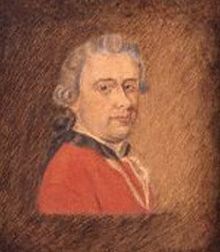Thomas Patch
Thomas Patch ( baptized March 31, 1725 in Exeter , † April 30, 1789 in Florence ) was a British painter, caricaturist and engraver, who mainly lived in Italy.
Life
Patch was the son of a surgeon and should also become a doctor, like two of his brothers who also became surgeons. Even during his apprenticeship with a pharmacist, he preferred to draw caricatures of the townspeople of Exeter . Before finishing his medical studies, he went on the Grand Tour and came to Rome in 1747. There he met Joshua Reynolds , with whom he became friends, and turned to painting, initially in the studio of the French painter Claude Joseph Vernet . He painted pastiches of his works and his own landscapes, for example from Tivoli (Latium) . One of his patrons in Rome (and generally a patron of artists) was the Irish Lord Charlemont (1728–1799), who had been in Rome since 1748, had founded the Academy of English Professors of the Liberal Arts and Patch as a member of commissions for pictures gave. Known in Rome for his belligerence and frank words, Patch was described by contemporaries as eccentric. He came into conflict with the Inquisition in Rome as early as 1751 and had to leave Tivoli in the same year on the instructions of the bishop. In 1755 he had to leave Rome on the instructions of the Inquisition, although the exact reason is not known. Patch went to Florence , where he was a close friend of the British envoy Horace Mann . He portrayed and caricatured British travelers on grand tours and was also an art dealer. His pictures were very popular with British people traveling through. He is depicted in a well-known portrait of English art lovers in Florence, Italy by Johann Zoffany ( The Tribuna of the Uffizi ).
In 1763 he painted three views of Florence, which (possibly acquired directly by George III ) went to the British Royal Collection. He also painted David Garrick on his visit to Italy and in October 1767 the eruption of Vesuvius .
In 1772 he published a book about the Tuscan Renaissance painter Fra Bartolomeo (1472-1517).
gallery
Patch Lord William Cavendish , William FitzHerbert and their tutor Mr. Short , around 1780
literature
- Francis Watson Thomas Patch (1725-1782): Notes on his Life, together with a catalog of his own Works , Walpole Society, XXVIII, 1939-40, p. 40,
Web links
Individual evidence
- ↑ Francis Watson Thomas Patch , Walpole Society, gives Exeter as the date of birth in early 1725, he was baptized on March 31st. Entry at artfact.com
- ↑ Date of death according to Horace Mann's letters to Walpole. He suffered a stroke in Mann's house, dragged himself to his home across the street, and died a day later.
- ↑ First surgeon in Exeter Hospital and former surgeon of the Old Pretender at his court in St. Germain
- ↑ Warren Hoge When Italy Enchanted Touring Gentry , The New York Times, December 7, 1996, cites allegations of homosexual acts as the cause. There is none of this in Watson's paper. The exact reason for the deportation is not known to Patch, whose letter has been received, but as a Protestant he was not very popular in Rome. Patch himself could only imagine an affair with a girl in Tivoli from a long time ago.
- ^ A b The Royal Collection, Zoffany The Tribuna of the Uffizi
- ^ A View of the Arno in Florence by Day in the Royal Collection
- ^ A distant view of Florence in the Royal Collection
- ^ A view of the Arno in Florence by night in the Royal Collection
- ^ Guardian . David Garrick in Italy from Patch visits a palazzo with Horace Mann, whose portrait appears as the face of a bull in a painting in the background. The painting is in the Exeter Art Gallery.
| personal data | |
|---|---|
| SURNAME | Patch, Thomas |
| BRIEF DESCRIPTION | British painter |
| DATE OF BIRTH | baptized March 31, 1725 |
| PLACE OF BIRTH | Exeter |
| DATE OF DEATH | April 30, 1789 |
| Place of death | Florence |



